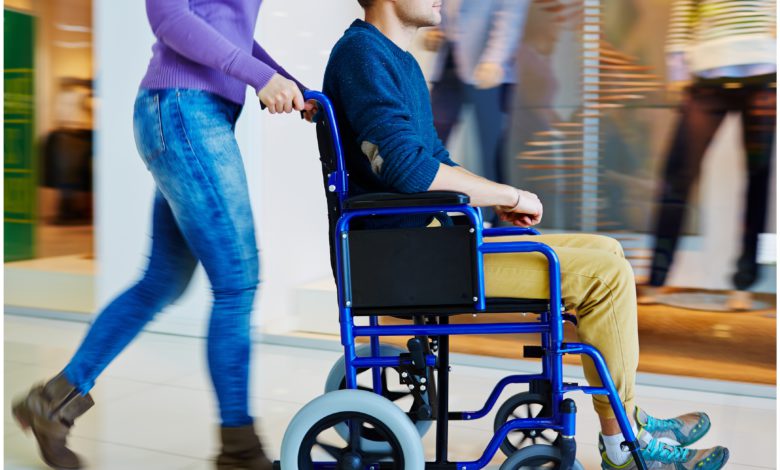A Guide to Wheelchair Travel and Airport Accessibility

Table of Contents
A Guide to Wheelchair Travel and Airport Accessibility
Navigating Airports with Ease: A Guide for Wheelchair Users
Air travel can be an exciting adventure, but navigating airports with a travel wheelchair can add a layer of complexity. Fear not, fellow travelers! This guide equips you with valuable information to ensure a smooth and accessible airport experience.
Booking Your Flight:
- Inform the Airline: When booking your flight, notify the airline that you’ll require wheelchair. assistance. This allows them to make the necessary arrangements for your arrival and departure.
- Pre-Board Request: Consider requesting pre-boarding to avoid potential congestion and ensure ample time for boarding assistance.
Packing Smart:
- Pack Light: Remember, you might need assistance with luggage. Pack light and consider using a carry-on bag if possible.
- Essential Items: Pack any medications, medical equipment, or other important items you might need during your travel day in your carry-on for easy access.
Arrival at the Airport:
- Designated Parking: Most airports have designated parking spots closer to the terminal for travelers with disabilities.
- Wheelchair Assistance: Upon arrival, inform airport staff or airline personnel about your need for wheelchair assistance. They will guide you through security screening and to your gate.
Security Screening:
- Screening Process: Security checkpoints have designated lanes for travelers with disabilities. You might need to transfer to a security screening chair for the screening process.
- Assistance Available: Trained security personnel will be available to assist you with the screening process and ensure your comfort and safety.
Boarding and Deplaning:
- Priority Boarding: Many airlines offer priority boarding for passengers with disabilities. This allows you to board before the main crowd and get settled comfortably.
- Transfer Assistance: Airport staff will be present at the gate to assist you with transferring from your wheelchair to the airplane seat. The same assistance will be provided upon deplaning.
Tips for a Smooth Journey:
- Plan Ahead: Familiarize yourself with the airport layout beforehand. Many airports offer downloadable maps with accessible features highlighted.
- Charge Up: If you use a power wheelchair, ensure it’s fully charged before your trip. Some airports might have charging stations available, but it’s always best to be prepared.
- Bring a Companion: Consider having a travel companion to assist you throughout the airport process, especially if you require additional support.
- Relax and Enjoy: With proper planning and the assistance available, air travel can be an enjoyable and accessible experience.
Beyond the Wheelchair: General Accessibility Tips
Airports cater to a wide range of accessibility needs. Here are some additional tips:
- Visual Impairment: Many airports offer assistance for visually impaired passengers, including audio descriptions of announcements and Braille signage.
- Hearing Impairment: Assistive listening devices can be requested at security checkpoints and boarding gates.
- Hidden Disabilities: Some disabilities may not be readily apparent. Consider using a hidden disability lanyard to inform airport staff of your needs discreetly.
How much do you tip for wheelchair at airport?
While tipping for wheelchair assistance at airports isn’t mandatory, it’s a kind gesture to show appreciation for the service. Here’s a breakdown to help you decide:
- General Tip Range: The typical tip range for wheelchair assistance at airports falls between $3 and $10.
- Factors to Consider: A few factors can influence your tip amount:
- Length of Assistance: A longer journey or assistance with multiple tasks (like navigating security or baggage claim) might warrant a higher tip.
- Level of Service: If the attendant goes above and beyond, like helping you use the restroom or grab a snack, a slightly higher tip shows your gratitude.
- Local Customs: Tipping customs can vary depending on your location. Researching tipping etiquette at your specific airport might be helpful.
Here are some additional things to keep in mind:
- No Pressure: There’s no pressure to tip, and some wheelchair attendants might not be allowed to accept them due to airport policies.
- Alternatives to Cash: If tipping isn’t allowed, consider expressing your appreciation verbally or offering a small gift like a water bottle or snack.
- Always Be Respectful: Regardless of tipping, a simple “thank you” for the assistance goes a long way!
Following are the Scenarios, you may take into consideration while offering a tipping amounts for wheelchair assistance at the airports:
Scenario 1: Short Distance Assistance
Imagine you require a wheelchair for a short distance at the airport, like from the gate to baggage claim. The wheelchair attendant helps you with your luggage and delivers you efficiently. In this case, a tip of $3-$5 would be appropriate.
Scenario 2: Extended Assistance
Let’s say you need wheelchair assistance throughout your entire airport journey, from check-in to security screening and finally to your boarding gate. The attendant helps you navigate the airport, answers questions, and ensures a smooth experience. Due to the extended service, a tip of $5-$10 would be more fitting.
Scenario 3: Exceptional Service
Perhaps the wheelchair attendant goes above and beyond by helping you use the restroom or grabbing a bottle of water while you wait at your gate. In this situation, a tip of $8-$12 would show your appreciation for their extra effort.
Remember: These are just examples, and the final tip amount depends on your specific situation and level of service received.
FAQs
- Do I need to pre-register for wheelchair assistance?
While pre-registration isn’t always necessary, informing the airline at the time of booking ensures they are prepared to assist you.
- What happens if my wheelchair battery dies?
Most airports have courtesy wheelchairs available. If your battery dies, inform airport staff, and they will be happy to assist you.
- Can I bring my medication through security?
Yes, you can bring medication through security. Inform security personnel of your medications, and they will guide you through the screening process.
- What should I wear while traveling in a wheelchair?
Comfort is key! Choose loose-fitting clothing that allows for easy movement and transferring. Avoid clothing that could get caught on wheelchair wheels.
- Can I bring my personal care items on board?
Yes, you can bring most personal care items in your carry-on luggage. However, there are limitations on liquids, gels, and aerosols. Check with the Transportation Security Administration (TSA) website for the latest guidelines on what you can pack https://www.tsa.gov/travel/travel-tips/travel-checklist.
- What if I have a connecting flight?
Inform the airline staff at your origin airport that you have a connecting flight. They will ensure a smooth transition between flights and provide any necessary assistance.
- What resources are available at the airport for people with disabilities?
Most airports have websites or accessibility information hotlines where you can find detailed information about accessible services, amenities, and resources available at the airport.
- What can I do if I encounter any accessibility issues at the airport?
Don’t hesitate to speak to airport staff. They are there to assist you and ensure a smooth travel experience. Additionally, many airports have designated disability support services offices that can address any concerns you may have.
Conclusion
Air travel can be an exciting and enriching experience for everyone. With a little planning and knowledge, airports can be just as accessible as any other destination. By following these tips and utilizing available resources, wheelchair users can navigate airports with confidence and ease, allowing them to focus on the joy of travel.
By following these tips and utilizing available resources, you can transform your wheelchair travel into a stress-free and empowering adventure!
Additional Resources:
- Airline Websites: Most airline websites have dedicated sections outlining their policies and procedures for passengers with disabilities.
- The TSA Website: The Transportation Security Administration (TSA) website provides detailed information about security screening procedures for travelers with disabilities: https://www.tsa.gov/
- Disability Rights Organizations: Organizations like the Christopher and Dana Reeve Foundation offer resources and information on accessible travel: https://www.christopherreeve.org/



